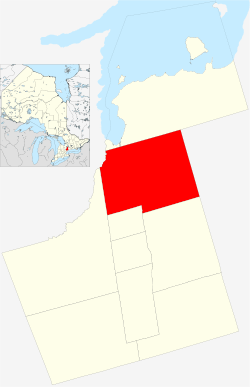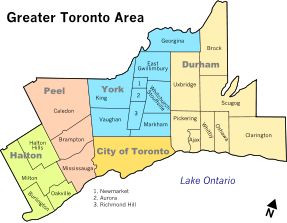East Gwillimbury
| East Gwillimbury | ||
|---|---|---|
| Town (lower-tier) | ||
| Town of East Gwillimbury | ||
|
| ||
| ||
| Motto: Our Town, Our Future![1] | ||
 Location of East Gwillimbury York Region. | ||
 East Gwillimbury Location of East Gwillimbury York Region. | ||
| Coordinates: 44°08′N 79°25′W / 44.133°N 79.417°WCoordinates: 44°08′N 79°25′W / 44.133°N 79.417°W | ||
| Country |
| |
| Province |
| |
| Regional Municipality | York Region | |
| Township of East Gwillimbury | 1850 | |
| Town of East Gwillimbury | 1971 | |
| Government | ||
| • Type | Municipality | |
| • Mayor | Virginia Hackson | |
| • Councillor |
James R. Young Tara Roy-Diclemente Marlene Johnston Joe Persechini | |
| Area[2] | ||
| • Total | 245.03 km2 (94.61 sq mi) | |
| Population (2011)[2] | ||
| • Total | 22,473 | |
| • Density | 91.7/km2 (238/sq mi) | |
| • Growth | +6.7% (2,006-2,011) | |
| Time zone | EST (UTC-5) | |
| • Summer (DST) | EDT (UTC-4) | |
| Area code(s) | 905 | |
| Website | www.eastgwillimbury.ca | |
East Gwillimbury is a town on the East Holland River in the Regional Municipality of York. It is part of the Greater Toronto Area of southern Ontario, in Canada. It was formed by the amalgamation of the Township of East Gwillimbury with all the previously incorporated villages and hamlets within the township. The main centres in East Gwillimbury are the villages of Holland Landing, Queensville, Sharon, and Mount Albert. The Civic Centre (municipal offices) are located along Leslie Street in Sharon. The northernmost interchange of Highway 404 is at the North edge of East Gwillimbury, just south of Ravenshoe Road. The hamlets of Holt and Brown Hill are also within town limits.
East Gwillimbury takes its name from the family of Elizabeth Simcoe, née Gwillim, wife of Sir John Graves Simcoe, first Lt. Governor of the province.
Government
The municipal council consists of a mayor and four councillors elected at large, with the mayor also representing the town in York Regional Council. The current and recent mayors are:[3]
| Mayor | Overall Term |
|---|---|
| Virginia Hackson | 2010 to present |
| James Young | 2000 to 2010 |
| Jim Mortson | 1991 to 2000 |
| Robert Featherstonhaugh | 1985 to 1991 |
| Angus Morton | 1977 to 1985 |
| Gladys Rolling | 1970 to 1976 |
In the 2010 election, Virginia Hackson was elected mayor, with Cathy Morton and Marlene Johnston re-elected as councillors. Joining them were Tara Roy-DiClemente and John Eaton.[4]
In the 2014 election Virginia Hackson was re-elected as Mayor, with a council consisting of Tara Roy-DiClemente, Marlene Johnson, James Young and new member Joe Persechini. [5]
The Federal Member of Parliament is Peter Van Loan, a member of the Conservative Party of Canada, representing the riding of York—Simcoe.
The Member of Provincial Parliament is Julia Munro, a member of the Progressive Conservative Party of Ontario, representing the provincial riding of York—Simcoe.
Emergency services
The town operates three fire and emergency services locations, in Holland Landing, Mount Albert and Queensville. They are each staffed by a District Fire Chief and volunteer firefighters.[6]
Police services are provided by the York Regional Police.
Planning
In March, 2006 the town council passed a policy during the Committee of the Whole Council Meeting which requires all residential developments of at least ten units to comply with Energy Star qualifications.[7] The town's mayor described potential benefits of the program: "Energy efficient housing is the best way to ensure that East Gwillimbury's residents are insulated against rising energy costs and won't have to make costly energy efficiency upgrade retrofits in the future."[7] The program was developed in conjunction with the development community, and stipulates "that homes in new subdivisions must — emphasis here on must — have some of the most efficient hot water, heating and air conditioning systems, be upgraded with top-rated insulation, and have draft-proof windows."[8]
East Gwillimbury is the first jurisdiction in Canada to require Energy Star certification for residential units.
The 2010 Official Plan
| Census | Population |
|---|---|
| 1981 | 12,565 |
| 1991 | 18,367 |
| 2001 | 20,555 |
| 2006 | 21,069 |
| 2011 | 22,473 |
In June 2010, town council passed the Official Plan for the Town of East Gwillimbury. The Official Plan was praised for its consultations[9] with the public, developers as well as other stakeholders. Designated as a future growth area under the Places to Grow Act by the Province of Ontario, East Gwillimbury will see growth from 23,000 residents in 2010, to approximately 88,400 people and 34,000 jobs by the year 2031. Despite the large amount of growth, almost 75% of East Gwillimbury land will not be developed as it is part of both the Greenbelt and the Oak Ridges Moraine. Rather than being spread out throughout the town, growth will be concentrated in the existing villages of Holland Landing, Sharon, Queensville and Mount Albert, and will be more exurban rather than suburban in nature. Queensville will see the most growth, going from a population of 650 people in 2010, to over 30,000 residents. Much of the growth has been proposed since the early 1990s however, growth in East Gwillimbury cannot occur until the York-Durham Sewage System is extended into the town, which has been postponed until 2012 or 2013, when costs are lowered. In October 2011, the Regional Municipality of York advised the Ontario Municipal Board, that they support the Official Plan for East Gwillimbury.
Attractions
The Sharon Temple is located in the village of Sharon, Ontario. It was designated as a National Historic Site of Canada in 1990. The site is composed of eight distinctive heritage buildings and dwellings, and houses 6,000 artifacts on a 1.8 ha. site. The Temple was constructed between 1825 and 1832 by the "Children of Peace", a Quaker sect led by David Willson on whose property it was built.
-

The Sharon Temple, Sharon, Ontario circa 1860.
-

David Willson's Study, Sharon Temple Museum
-

Richard Coates' Keyboard Organ, Sharon Temple Museum
-

Rebellion Box, Sharon Temple Museum
-

Jacob's Ladder, Sharon Temple
-

Sharon Temple Today

Bare Oaks Family Naturist Park is a naturist (nudist to some) park located between the villages of Sharon and Mount Albert. It attracts thousands of visitors to East Gwillimbury and has a significant economic impact on area tourism.[10] It has been in that location since 1972 when it was known as the Toronto Helios Society.[11]
Education
Schools in East Gwillimbury are governed by the York Region District School Board and the York Catholic District School Board. There are several elementary schools. Under the public system, the school board operates Holland Landing Public School, Park Avenue Public School, located in Holland Landing. Sharon Public School, Queensville Public School and Mt. Albert Public School are located in Sharon, Queensville and Mount Albert respectively. The York Catholic District School Board operates Good Shepherd Catholic School (Holland Landing and Our Lady of Good Counsel Catholic Elementary School in Sharon). There are currently no secondary schools in East Gwillimbury, so students in Holland Landing attend Dr. John M. Denison Secondary School in Newmarket and students from Sharon, Queensville and Mount Albert attend Huron Heights Secondary School, also in Newmarket. Good Shepherd and Our Lady of Good Counsel students may proceed to Sacred Heart Catholic High School for secondary school. No post-secondary campuses are located in East Gwillimbury, though there are plans to bring a post-secondary institution to the Queensville area. East Gwillimbury's newest public school, Phoebe Gilman Public School, opened in 2013 in the Harvest Hills neighbourhood.
Transportation
Local public transportation is provided by York Region Transit, who operate bus services to Sharon, Holland Landing and Mount Albert. GO Transit also offers commuter train and bus services to Toronto through its East Gwillimbury Station.
Ontario Highway 404 has been extended to just south of Keswick in the Town of Georgina, passing through East Gwillimbury.
History
East Gwillimbury began with the early development of Upper Canada by Lieutenant-Governor John Graves Simcoe in the late 18th century. On his order, Yonge Street was constructed from Lake Ontario to what is now the village of Holland Landing in East Gwillimbury. The areas to the north and east were named East Gwillimbury and North Gwillimbury in honour of Simcoe's wife, Elizabeth Gwillim.[12] In 1849 the Baldwin Act incorporated the Township of East Gwillimbury effective January 1, 1850. The Province of Ontario incorporated the Town of East Gwillimbury effective January 1, 1971.[13]
As the East Gwillimbury area grew, a number of communities developed. They were the villages or hamlets of Brown Hill, Franklin, Holland Landing, Holt (formerly Eastville), Mount Albert, Queensville (formerly colloquially known as The Four Corners), Ravenshoe, River Drive, and Sharon (formerly Hope).[12]
In 1913, all township records were destroyed in a fire at the clerk's office in Queensville. [14]
Famous residents (past and present)
- Sam Bennett, NHL player with the Calgary Flames
- John Candy, actor and comedian
- Ebenezer Doan, Master Builder of the Temple
- Samuel Lount, organizer of the 1837 Upper Canada Rebellion.
- Curtis Joseph, retired NHL Goalie
- David Willson, founder of the Children of Peace.
See also
References
- ↑ "2010 Residents Guide" (PDF). Town of East Gwillimbury. p. 6. Retrieved 2011-01-20.
- 1 2 "East Gwillimbury census profile". 2011 Census of Population. Statistics Canada. Retrieved 27 May 2015.
- ↑ "Chain of Office". Town of East Gwillimbury. Archived from the original on 9 August 2006. Retrieved 18 November 2012.
- ↑ "East Gwillimbury 2010 Official Election Results". Town of East Gwillimbury. Retrieved 30 December 2013.
- ↑ "2014 Municipal Election Certified Results". The Town of East Gwillimbury. Retrieved 24 March 2015.
- ↑ http://www.eastgwillimbury.ca/municipl/services.htm
- 1 2 "East Gwillimbury – First in Canada to Adopt ENERGY STAR Standards for New Housing" (PDF). Town of East Gwillimbury. 2006-05-15. Archived from the original (PDF) on June 14, 2006. Retrieved 2006-06-19.
- ↑ Hamilton, Tyler (2006-06-19). "Town raises bar on efficiency". Toronto Star. Retrieved 2006-06-19.
- ↑ http://www.yorkregion.com/news/article/568062--have-your-say-in-east-gwillimbury-s-future
- ↑ Committee of the Whole Meeting Minutes, East Gwillimbury, June 11, 2012
- ↑ Woycke, James (2003). Au naturel : the history of nudism in Canada. Etobicoke, Ontario: Federation of Canadian Naturists. ISBN 0-9682332-3-6.
- 1 2 Millier Dickinson Blais (2012). Town of East Gwillimbury Cultural Mapping Project (PDF). Town of East Gwillimbury. p. 7.
- ↑ "Ontario Archives". Gazetteer of Ontario, 1962, p. 160. Government of Ontario. Retrieved 30 December 2013.
- ↑ Rolling, Gladys M. (1967). "Preface". East Gwillimbury in the nineteenth century. Ryerson Press.
External links
| Wikimedia Commons has media related to East Gwillimbury, Ontario. |
- Town of East Gwillimbury
- Sharon Temple National Historic Site
- East Gwillimbury Public Library
- Ontario Plaques - Samuel Lount
- Ontario Plaques - Sharon Temple
 |
Georgina |  | ||
| Bradford West Gwillimbury King |
|
Uxbridge | ||
| ||||
| | ||||
| Newmarket, Whitchurch–Stouffville |
| ||||||||||||||||||
| ||||||||||||||||||||||||||||||
